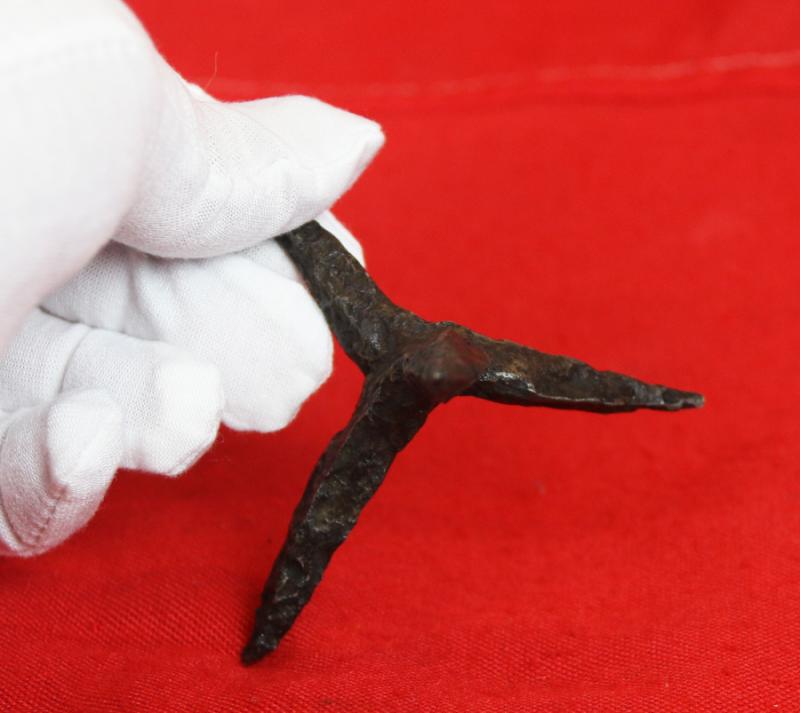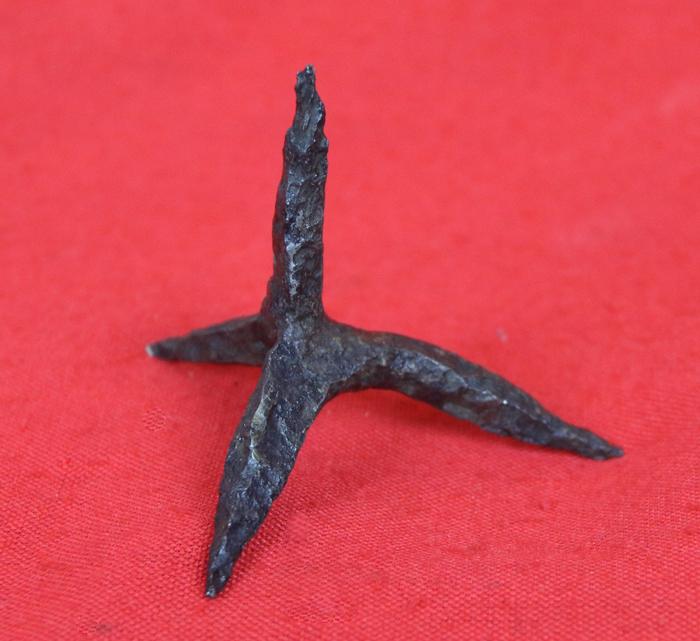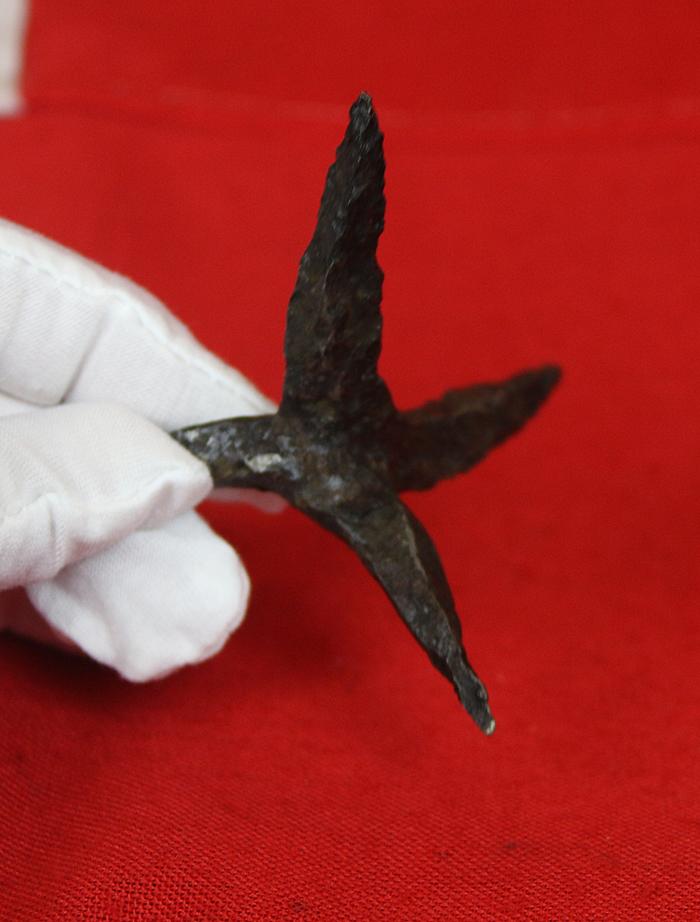An Original Medieval Caltrop 13th-15th Century, Recovered From the Battle Site of Agincourt. Known to The Ancient Romans As A Tribulus. One of The Oldest Forms of Incredibly Effective Combined Offensive & Defensive Strategies of War
Part of an incredible collection of Roman, Viking, and Medieval antiquities we have just acquired, including these amazingly interesting pieces, a few, original, battlefield recovered caltrops from the Anglo French wars of the 14th and early 15th centuries, all acquired from a ‘Grand Tour’ of 1820, either from the regions surrounding the battle site of Agincourt, . Some were listed specifically as from Agincourt, others as from either the Poitiers or Crecy battle sites. However they were all constructed the same by English blacksmith armourers, between 600 to 700 years ago. As well as historically incredibly interesting it is also an amazing, and especially a somewhat gruesome, conversation piece.
In many respects as equally important to the medieval former King’s armies at the time as the long bow and arrow. Yet they have almost disappeared from the history books as to their incredible significance and highly useful service in all of those battles. For example, by just 50 men casting thousands of these caltrops, across, say, a 25 acre field, it would effectively deny an entire French army the ability to out-flank the British across that particular terrain. Thus, with that ingenious ability, a king could manipulate to a great degree, and with relative ease, an entire defensive or offensive position for an oncoming battle, or even hopefully negate a surprise attack from a particular direction. And to caste them behind the ranks of a retreating army would create a huge advantage potentially for survival against an attack from behind. There is no greater advantage to the discouragement of an enemy French foot soldier to know that he, and up to fifty percent of his pursuing force comrades, might well be crippled for life before even engaging with the enemy English in hand to hand combat. Upon being caste on hard and barren flat ground, in daylight, they would be easy to spot and thus, with relative caution, avoid, but upon grassy ground, or woodland, especially when the ground was wet, they would be near impossible to see.
The caltrop is an ancient anti-personnel weapon made up of forged and very heavy grade sharp nails or spines arranged in a pyramidical manner so that one of them always points upward from a triple spine stable base. In the wars with France they could be issued to English foot soldiers to caste behind if they made a rapid withdrawal and were likely to be pursued. Used thus they would incapacitate, often permanently, an infantryman or foot knight, if trodden upon, and create the same result if trodden upon by a harsh man’s mount. They would also be forged in significant numbers in order to remove or deny an area of a battlefield or defences from the enemy’s access. The prominent spike being of such a height and strength, they would easy penetrate the thickest leather shoe sole, and especially a bare foot or hoof, as many medieval soldiers marched and fought barefooted.
Iron caltrops were used as early as 331 BC at Gaugamela according to Quintus Curtius (IV.13.36). They were known to the Romans as tribulus or sometimes as Murex ferreus, the latter meaning 'jagged iron'.
Richard Lassels, an expatriate Roman Catholic priest, first used the phrase “Grand Tour” in his 1670 book Voyage to Italy, published posthumously in Paris in 1670. In its introduction, Lassels listed four areas in which travel furnished "an accomplished, consummate traveler" with opportunities to experience first hand the intellectual, the social, the ethical, and the political life of the Continent.
The English gentry of the 17th century believed that what a person knew came from the physical stimuli to which he or she has been exposed. Thus, being on-site and seeing famous works of art and history was an all important part of the Grand Tour. So most Grand Tourists spent the majority of their time visiting museums and historic sites.
Once young men began embarking on these journeys, additional guidebooks and tour guides began to appear to meet the needs of the 20-something male and female travelers and their tutors traveling a standard European itinerary. They carried letters of reference and introduction with them as they departed from southern England, enabling them to access money and invitations along the way.
With nearly unlimited funds, aristocratic connections and months or years to roam, these wealthy young tourists commissioned paintings, perfected their language skills and mingled with the upper crust of the Continent.
The wealthy believed the primary value of the Grand Tour lay in the exposure both to classical antiquity and the Renaissance, and to the aristocratic and fashionably polite society of the European continent. In addition, it provided the only opportunity to view specific works of art, and possibly the only chance to hear certain music. A Grand Tour could last from several months to several years. The youthful Grand Tourists usually traveled in the company of a Cicerone, a knowledgeable guide or tutor.
The ‘Grand Tour’ era of classical acquisitions from history existed up to around the 1850’s, and extended around the whole of Europe, Egypt, the Ottoman Empire, and the Holy Land.
Caltrops, known as tribulus to Romans, were recorded as used as such in the Battle of Carrhae in 51 BC.
The late Roman writer Vegetius, referring in his work De Re Militari to scythed chariots, wrote:
The armed chariots used in war by Antiochus and Mithridates at first terrified the Romans, but they afterwards made a jest of them. As a chariot of this sort does not always meet with plain and level ground, the least obstruction stops it. And if one of the horses be either killed or wounded, it falls into the enemy's hands. The Roman soldiers rendered them useless chiefly by the following contrivance: at the instant the engagement began, they strewed the field of battle with caltrops, and the horses that drew the chariots, running full speed on them, were infallibly destroyed. A caltrop is a device composed of four spikes or points arranged so that in whatever manner it is thrown on the ground, it rests on three and presents the fourth upright. Undoubtedly the most unusual weapon or military device surviving from seventeenth-century Virginia in America was a caltrop, a single example of which has been found at Jamestown. In fact their importance of use in close combat warfare was so important they were still in use by the British and US special services of the SOE & the OSS, as anti tyred vehicle sabotage devices, caste upon roads and lanes to incapacitate German trucks and staff cars.
Although by then, hand forging was fortunately redundant, as modern manufacturing methods could easily create pointed hollow steel tubed versions to ensure an immediate deflation of tyres.
The Battle of Agincourt;
After several decades of relative peace, the English had renewed their war effort in 1415 amid the failure of negotiations with the French. In the ensuing campaign, many soldiers perished due to disease and the English numbers dwindled, but as they tried to withdraw to English-held Calais they found their path blocked by a considerably larger French army. Despite the disadvantage, the following battle ended in an overwhelming tactical victory for the English.
King Henry V of England led his troops into battle and participated in hand-to-hand fighting. The French king of the time, Charles VI, did not command the French army himself, as he suffered from severe psychotic illnesses with moderate mental incapacitation. Instead, the French were commanded by Constable Charles d'Albret and various prominent French noblemen of the Armagnac party.
This battle is notable for the use of the English longbow in very large numbers, with the English and Welsh archers forming up to 80 percent of Henry's army. The decimation of the French cavalry at their hands is regarded as an indicator of the decline of cavalry and the beginning of the dominance of ranged weapons on the battlefield.
Agincourt is one of England's most celebrated victories. The battle is the centrepiece of the play Henry V by Shakespeare. Juliet Barker in her book Agincourt: The King, the Campaign, the Battle ( published in 2005) argues the English and Welsh were outnumbered "at least four to one and possibly as much as six to one". She suggests figures of about 6,000 for the English and 36,000 for the French, based on the Gesta Henrici's figures of 5,000 archers and 900 men-at-arms for the English, and Jean de Wavrin's statement "that the French were six times more numerous than the English". The 2009 Encyclopædia Britannica uses the figures of about 6,000 for the English and 20,000 to 30,000 for the French.
Generic photos are used here in the photo gallery as they are all taken from of our small collection are extremely similar looking examples of rare, finely handcrafted, original, medieval hammer forged workmanship, recovered from ancient battle sites. Their three dimensional proportions shows they all, approximately, occupy same size {though not shape of course} as an English cricket ball. And they are all now superbly conserved for another millennium, for the enjoyment of future generations for fascinating historic interest.
Code: 23981
195.00 GBP





